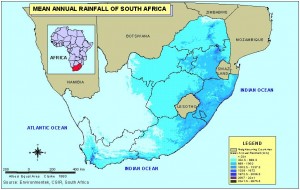South Africa is quite a dry country. Hard to believe after the storms that recently hit Cape Town, but our average rainfall is 500mm/year, while the world average is 860mm.
The light blue area in the map is desert. Namaqualand, Richtersveld, Karoo… stunning landscape, but dry.
We are also in the middle of an energy crisis. It seems that our electricity utility and / or government decided that the minimum of maintenance was all that was required to bring the country into the 21st century, so no new power stations were built while the economy and the population boomed.
The greenies suggest hydro-electric, wind and solar power, because they don’t like nuclear. Nothing wrong with hydro-electricity, if you don’t mind pouring your drinking water into the sea (the power you can extract from the water is a function of the mass and the difference in height, so to extract the maximum power the water needs to end up at sea level).
Wind and solar farms don’t seem to work well anywhere in the world, but it does work well on a local, distributed level — especially solar, in the form of solar geysers. Although, with our current low (even after rates increased) cost of electricity, it takes at least five years to break even on the installation cost. Unless you do-it-yourself, which I am planning on doing (Backwoods Home Magazine has some good articles, tips and ideas).
Out-of-the-box way of going solar : hang your clothes on the line instead of using a tumble drier.
Looking at the future, I see three crunches approaching. Two are related — fuel and electricity. With nuclear power stations we can manage the electricity supply, but fuel shortages will force us to change the way we live.
The third crunch is water. We already have periodic shortages, maybe coupled to the 11 year Solar Cycle. With population increasing, we’re going to have to take a serious look at how we use water.
Studies say that 3/4 of the water we use is in the bathroom, with your toilet(s) alone accounting for nearly 1/3. The toilet we’re fitting in the new bathroom is a dual flush unit. These use a lot less water than the traditional toilets, firstly because of a more efficient design (a full flush takes 5 or 6 litres, while the traditional toilets use closer to 18 litres, they tell me — and sticking a brick in the tank does reduce the amount of water per flush, but because the toilet was not designed for it, it also leads to incomplete flushes, so you flush twice, using even more water), and secondly because you can select a “half flush” if there are no floaty bits that need flushing.
Out-of-the-box way of saving water in the bathroom : if you’re a guy, go outside. This not only saves half a flush of water, it also helps water your plants — two savings for the price of one. Oh, and it might even help keeping porcupines away.
